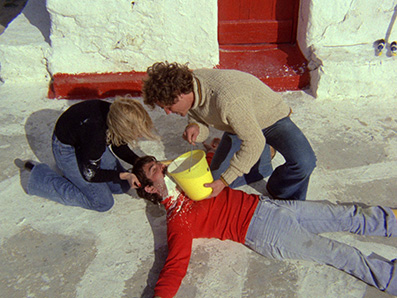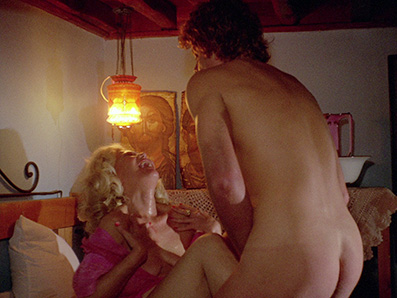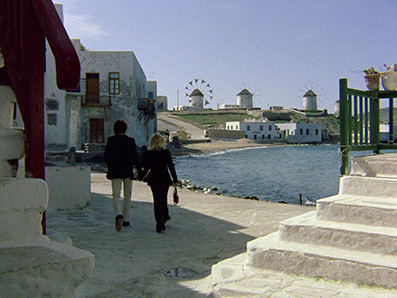"This is a movie that I myself don't take pleasure in
watching. I don't understand why people think it's a
cult movie. I don't understand why people watch it." |
Island of Death director Nico Mastorakis on Island of Death |
Christopher and Celia are a young English couple who've gone on holiday to the Greek island of Mykonos. Christopher hails from that little known corner of England where everyone speaks with an American accent, while Celia appears to have spent a couple of terms practicing her line delivery at a drama school for aspiring porn stars. It's an idyllic location, all sea and sun and white-walled buildings, and peaceful enough to suggest that it's too early in the season for the infestation of sweaty tourists that will surely follow. We gather from the big Nikon he has dangling from his neck that Christopher is a bit of a photographer, but he's one of those ones that you only find in movies who shoot a film's worth of pictures of nothing in particular because their camera has a high-speed motor drive and they can't seem to take their damned finger off the shutter release.
We're clued in from an early stage that something's not quite right with this pleasant looking pair when Christopher calls his mother in London (handily, she lives near enough to the chimes of Big Ben for the filmmakers to avoid having to fly there for location shots) from a public phone box specifically to offend her with the sound of him having sex with Celia. Oh, he's a lad. Be ready to recall this sequence from a different perspective when you get to the final scenes. Later, when the couple are having dinner, Christopher gets angry at the way the restaurant's only other guest is looking at his girl, so angry that he invites the man over for a drink and a friendly chat. Eh? On their way back to the house they have rented, Christopher spies a woman through a window having sex and his back is instantly up again. "Bitch!" he snaps angrily. "It's not her husband, she's a bitch!" Quite how this newcomer to the island knows this to be true is anybody's guess, but by this point he's on a roll. "She's a bitch," he continues, "a bloody bitch is what she is. If I was her husband, I'd kill her." Bloody hell, man, take a pill or something.

This, as it turns out, is minor league stuff. The next morning our Chris wakes up with a hard-on that Celia is too tired to have anything to do with, so he wanders outside, grabs a young goat and gives that a serious rogering instead. He then picks up a knife and stabs the animal to death. It's at this point you realise that in terms of where the film might take its characters or what it's prepared to show us, all bets are off.
Once Celia gets up, she wanders over to meet the man they were chatting with in the restaurant last night. He's French and a painter, a Lothario cliché that's amusingly undermined when it's revealed that he's actually painting the exterior of his house. Celia lends and hand and the two are soon splodging each other with wet paintbrushes, and in no time at all are getting down and dirty. It's at this point that the secretly watching Christopher appears to get all excited and starts snapping off pictures of his girlfriend being given a seeing-too by a man he was previously angry at just for looking in her direction. Having got what he needs, he then slips a noose round the man's neck and crucifies him by nailing his hands to the stone porch of a local church, then drowns him by pouring a bucket of purifying white paint into his mouth. Far from being horrified, Celia picks up the camera and starts banging off shots of her man's murderous antics, then holds the victim's head up while Chris pours in the paint.
It soon becomes clear that Christopher – whose name, if you want to play that game, could be a melding of 'Christ' and 'photographer' – is a twisted religious nutball with a furious loathing for anyone he deems as corrupting and immoral, which frankly seems to include just about everyone he claps eyes on. This from a man who fucks and kills goats before breakfast. His subsequent targets include a cheerful and socially popular homosexual couple, a casual heroin-using lesbian barmaid, a black private eye who has tracked them from London (you want to guess what Christopher calls him?) and a middle-aged female sexual predator, whom he seduces and pees on before beheading with a bulldozer. Yes, you read that right.

Although he occasionally appears to put a little thought into his misdeeds, Christopher is for the most part an impulse driven serial killer. Handy, then, that there always seems to be a knife, a scythe or a hammer left lying around when the call to murder takes him. Initially his willing accomplice, Celia later begins to have doubts about what they are doing (a bit bloody late for the poor sod whose brains she blew out after she stuck a gun in his mouth), which you just know is going to be Christopher's ultimate undoing, something clearly signaled in the opening scene.
Island of Death famously came to be when Greek director Nico Mastorakis attended a screening of The Texas Chainsaw Massacre, learned how much money this low budget film had made, and decided to make a cheaper and even more shocking film with the sole intention of raking in some serious dosh. He thus threw in just about everything he could think of that would startle and offend an even mildly sensitive audience, and on that score I'd say he delivered on his intentions. I'd even go as far as to suggest that the film's shock value may well be still as great as it was back when it hit UK video shelves back in the early 80s, when the surfeit of taste-busting horror to which us genre junkies were exposed had better primed us for the extremity of what's served up here. Mind you, we weren't given long to catch it, as in the UK it fell victim to the 1984 Video Recordings Act and soon found pride of place as a banned title on the notorious Video Nasties list.
All these years later I'm still not completely sure how I feel about Island of Death. Few films have an antihero who's a bigger arse than our Christopher, and I've always has a sneaking suspicion that the admittedly cute and oddly innocent-looking Jane Lyle landed the role of Celia primarily because she seemed so willing to get her kit off. The dialogue is sometimes on a par with the exchanges in the first Resident Evil video game, though not quite as funny, and there is so much dodgy acting (including a bumbling turn from director Mastorakis, who took the part when he couldn't afford the $80 that the real actor demanded) that it's easy to overlook the moments when naturalism gets a look-in and a performance feels real. Surprisingly, perhaps, the effects are rather good for a micro-budget feature, even if a couple do prompt a bit of a double-take, as when Christopher angrily slams a garden scythe through a door at what appears to be head height and the blade is then shown protruding from the chest of the girl on the other side. We can presume that in her terror she stood on a box.

But for a hardened horror fan, it's hard not to warm to any film whose intentions are so amorally pure and whose amateurism in some areas is so strikingly counterbalanced by technical polish in others. The storytelling has a ramshackle, made-it-up-as-we-went-along quality that I actually found rather endearing, but what really hits you in this new restoration is how utterly gorgeous it looks. The location is lovely, sure, but cinematographer Nick Gardellis (and when he was unavailable, director Mastorakis) really does it justice, making the locale part of the story and intermittently slapping on a fisheye lens to accentuate the madness of what's unfolding in front of us. There's also a degree of brutality that goes a step beyond the artificially choreographed, low-budget norm. Seriously, when blows and kicks are delivered, no-one appears to have told the performers to pull their punches. That Christopher so angrily targets homosexuals may have the sniff of extreme right-wing moralising, but while Paul may be almost as camp as South Park's Big Gay Al, he's sympathetically presented and his marriage party has a genuinely warm and celebratory air. And despite Christopher's lead role in the narrative, we're never allowed to forget who the real monster is here.
For all its peculiarities, Island of Death remains a strangely seductive work. Even the artificiality of its performances started to grow on me this time around, creating a sometimes disorientating sense of otherworldliness that makes even the familiar feel oddly unsafe. It's also a rare example of brightly sunlit horror, and while it falls some way short of the terrifying brilliance of Narciso Ibáñez Serrador's 1976 Who Can Kill a Child?, visually the two films could almost be blood brothers.
This restoration here was carried out by Arrow Films from the original camera negative with assistance from director Nico Mastorakis. The framing is a surprising 1.33:1 – this would likely be true to the image on the negative, but I'd be surprised if it was projected that way in cinemas. But hell, what do I know? Since Mastorakis was involved in the restoration process, we can presume this is how he intended it to look and it certainly feels right. With that out of the way I can talk about how the image looks. One word: amazing. Seriously, this is one of the most beautiful restorations I've seen all year. The colour in particular is utterly gorgeous, signaled early on by the deep blue of the ocean and some vivid yellow fishing nets, but in the bright Greek sunlight just about everything looks sumptuous. Such lighting conditions also allow for a generous contrast range without sacrificing black levels, and the sharpness and level of detail leave you in no doubt that you're looking at a Blu-ray. Dust, dirt and damage have been almost completely eliminated.

Late in the film, however, for a short time there is a noticeable drop in quality, which takes the edge off the previously pristine contrast, softens the colour and adds some slight shimmering. Apparently, at some time in its history, reel 5 of the camera negative was subjected to significant damage (the full details are in the accompanying booklet) and Arrow have done their best with what remains. It's not that bad and it doesn't last too long, and given how good the rest of the film looks you should take it in your stride.
The Linear PCM soundtrack was transferred by Nico Mastorakis prior to Arrow's work on the restoration. Thus while the dialogue is always clearly audible and the music distortion free, there are some audible instances of bumps, clicks, crackle and buzz that are more in-keeping with what you'd expect of a low budget horror work of this era.
Optional English subtitles for the deaf and hearing impaired are available.
Exploring Island of Death (38:26)
Film historian Stephen Thrower, the star contributor on Nucleus Films' wonderful Video Nasties: The Definitive Guide, provides a richly detailed and enthralling analysis of just about every aspect of the film (this extra was actually produced by Nucleus). Every title under which the film has appeared is covered here and we also get a comprehensive overview of the career of director Nico Mastorakis. But the main focus, appropriately, is Island of Death, coverage of which includes its inception, the actors, the variable performances, the more extreme content and the music score. There's also a fascinating exploration of the film's underlying themes and the discomforting effect of seeing the world through Christopher and Celia's eyes. It's headed up with a big spoiler warning and advice to watch the main feature first, which I really appreciate.

Return to Island of Death (16:57)
Director Nico Mastorakis plays horror tour guide for a cheerful trip around the Mykonos locations in which the film was shot. A small number of those who were there for the filming are briefly chatted to, and clips from the film are used for comparison – the surprise is how little the locations have changed in the past forty years. A couple of interesting titbits about the filming are also thrown in – I was particularly intrigued to learn that the crew used tricycles to transport film equipment down the narrow streets, and that the noise that they made when in motion saw them referred to as 'ear fuckers'. I've seen a few of these location revisit featurettes in recent years, but this is far and away my favourite to date, thanks in no small part to its genial host.
Nico Mastorakis Interview (23:44)
First talking straight to camera and then filmed in big close-up from a three-quarter angle and bathed in blue light, director Mastorakis provides some interesting insight into the making of the film and his intentions for it, a sizeable profit being his prime motivator. There's some great stuff in here, including that quote at the top of this review, and I warmed to his description of censors and those who appoint them as "a medieval paramilitary authority." Keep that in mind when Theresa May starts demanding that films be approved by the government before being released.* He also has this to say about his lead characters: "The twisted minds I depicted in Island of Death are absolutely nothing, they're kindergarten stuff compared to the twisted minds that walk among us today in every part of this world." He may well be right.
The Films of Nico Mastorakis (157:28 total)
Written and presented by Mastorakis and produced by his production company for his own earlier DVD releases of the work, this proves a borderline epic trip through his film career. Split into four parts of unequal length, it includes enough often lengthy clips from the films for each one to play like a cut-down version of the full thing. Should save you a trip to the video store. Once again Mastorakis proves a most engaging host and the behind-the-scenes footage and stories are most welcome. Once you start watching, it's hard to switch off, so don't start this one late at night.

Alternate Opening Titles
The main title sequence as it appeared on the film's release as Island of Perversion (0:50) and Devils in Mykonos (1:08).
Island Sounds (24:02)
An audio only extra that allows you to listen to five of the music tracks from a film whose score ranges from folky pop to a sort of abrasive Moog farting when Christopher attacks one poor soul with a sword. Three of the tracks here are songs, and whether you'll actually be giving them a regular spin will all be down to personal musical taste. They're very much products of their time and I was initially resistant, but Arrow's decision to loop the opening strains of the song Destination on the menu screen (thanks a lot, guys) has got the bloody thing stuck firmly in my head.
Nico Mastorakis Trailer Reel (34:16)
Just what it says, a trip through the trailers for ten of Mastorakis' exploitation films, namely Blind Date, Skyhigh, Glitch!, Nightmare at Noon, Bloodstone, Grandmother's House, Hired to Kill, In the Cold of the Night, The Naked Truth and .com for Murder. It's a fairly cheesy collection and plays a little like one of those grindhouse trailer discs that Nucleus put out for you to watch when you're drunk. I'm fairly sure I saw the same explosion in two separate trailers.
Booklet
24 pages long but with a lot of full and double page stills, the centrepiece of this booklet is an essay on the film and its release titled A Cruel Destination: The History and Legacy of Island of Death by Johnny Walker. There's also a couple of pages on the restoration, which usefully explain the reasons for the brief quality drop in the later stages. Main cast and crew details have also been included.
Wholeheartedly recommending a film like Island of Death would probably land it in front of someone who would be traumatised by what they saw, although the idea of triggering such a result does rather amuse me. Horror fans and particularly those with a fondness for 70s and 80s boundary pushers should certainly leap on this release if they haven't done so already. The transfer is gobsmackingly good, the extras terrific and their collective running time is more than twice that of the feature. For all my piss-taking, it's a disc I'm giddily happy to own.
* Unfortunately I'm not being fanciful for the sake of political point-scoring: http://bit.ly/1KVg63T
|